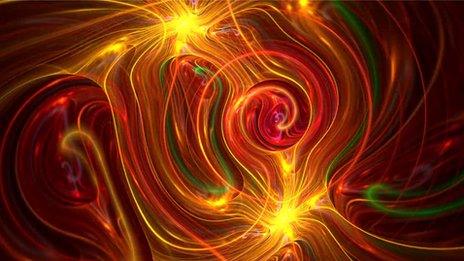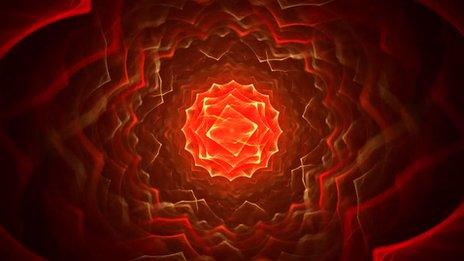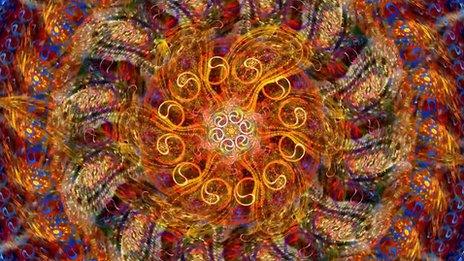The quest to turn computers into creative artists
- Published
Click reporter Lara Lewington composes her own music at the wheel.
With the London Symphony Orchestra performing machine-written symphonies, Amazon selling books written by algorithms and film-makers scripting screenplays after conversations with a PC, are computers evolving from being a mere tool into becoming a creative force in their own right?
One of the differences between humans and machines has often been said to be, external creative thought. But several efforts are under way to let computers seek inspiration from their surrounding environment to create art.
For example, a new experiment by Volkswagen creates music based on a car's speed, steering and whether it is in the city or countryside.
Prof Francisco Vico demonstrates how the computer works
Developed with the musicians Underworld - who composed the track played during the lighting of the London Olympics cauldron - the app generates music in real-time for passengers in the car.
"Everyone has driving experiences where the perfect song is on the radio to match their drive," says Matt Oxley, head of creative technology at Tribal Worldwide London, the company behind the app.
"It's that moment we want to emulate and re-examine."
Other efforts have gone further.
The Iamus project has taught a computer to write modern classical music at the touch of a button, taking account of performers' limitations - such as the number of fingers available to play notes.
Its works have been performed by the London Symphony Orchestra, external .

eDavid is a robotic arm that has been programmed with the capacity to paint and draw
Some might argue that computers will never be able to match human ingenuity but it is difficult these days to argue they can't at least mimic many of our skills.
Take the eDavid painting robot. The computer-controlled arm - adapted from a welding machine - chooses from five brushes and 24 colours to create impressive artworks on canvas.
It works by snapping a photo of its subject matter and then making the necessary calculations to turn the image into a drawing or painting in a wide variety of styles.
Its creators admit that it has no awareness of what it is doing. But it is able to make decisions about things like shading and brushstrokes as it goes, tweaking its moves based on how the picture is evolving, rather than just creating a pre-determined image.

Scott Draves's project is called Electric Sheep

It uses computers communicating with each other to create abstract animations

Known as sheep, each animation is created solely by computers

The "flock" evolves over time as each sheep mates with another one

Scott Draves sees the result as a collective "android dream"
One programmer is trying to go even further, and talks of abstract animations created by computers running his software as having "souls" of their own.
Scott Draves's program, Electric Sheep, uses processing power from volunteers' computers to create images that "mate and reproduce", so that they are constantly evolving.
The system - dubbed artificial life - is modelled on the way genetic change occurs in biology.
The only human involvement is to vote for favourite animations, effectively guiding the survival of the fittest.
"I want the computer to come back to me with the unexpected - to write a finite program which can produce infinite design," says Mr Draves, who was inspired by sci-fi author Philip K Dick.
"From that you can get something truly original. Even I, as the creator of the system, don't understand it any more.
"I don't put it on the same level as a human soul, but is it on the same level as a mouse? Is it an insect? Is it a bacterium? I don't know. It's its own thing but it does have some spark of its own."
Computers are also getting involved in movies by helping to write scripts.
Film-maker Chris R Wilson turned to Cleverbot - a website that uses an artificial intelligence algorithm to have conversations with humans - to create the dialogue for his short film Do You Love Me?
"We thought it would just be fun because it has these weird responses to everything," he has said, external.
"The charm of it was because it's so awkward and strange."
The bot's creator argues that his invention made a creative contribution to the process since its answers were not pre-programmed, but rather based on the software's ability to learn new words and stylistic tricks from the many conversations it has had since being launched in 1997.

Do You Love Me? tells the story of Stomach, Prometheus and Robert, part-written by Cleverbot
"My view is that creativity is about absorbing a lot of experience," says Rollo Carpenter.
"You could say it's just mimicking but in fact what happens, every time you talk to it, a new conversation ensues.
"Every conversation is different and you could say it is being creative by seeing connections between things that a person may or may not have seen. Therefore, it's being as creative as a real person might be."
Do You Love Me?, external may have ended up with a highly surreal plot that was dependent on Mr's Wilson's half of the conversation to lend it any sense of coherence.
But give Cleverbot and its artistic compadres a bit more time and they may astound us all.
- Published3 January 2013
- Published16 November 2013